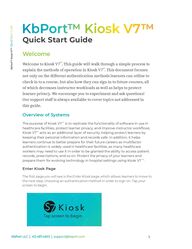
Return to flip book view
Message Quick Start Guide Welcome Welcome to Kiosk V7 ™ . This guide will walk through a simple process to explain the methods of operation in Kiosk V7 ™ . This document focuses not only on the different authentication methods learners can utilize to check in to a course, but also how they can sign in to future courses, all of which decreases instructor workloads as well as helps to protect learner privacy. We encourage you to experiment and ask questions! Our support staff is always available to cover topics not addressed in this guide. Overview of Systems The purpose of Kiosk V7 ™ is to replicate the functionality of software in use in healthcare facilities, protect learner privacy, and improve instructor workflows. Kiosk V7 ™ acts as an additional layer of security, helping protect learners by keeping their personal information and records safe. In addition, it helps learners continue to better prepare for their future careers as multifactor authentication is widely used in healthcare facilities, as many healthcare workers may need to use it in order to be granted the ability to access patient records, prescriptions, and so on. Protect the privacy of your learners and prepare them for evolving technology in hospital settings using Kiosk V7 ™ . Enter Kiosk Page The first page you will see is the Enter Kiosk page, which allows learners to move to the next step: choosing an authentication method in order to sign on. Tap your screen to begin. 1
Authentication Method Page After tapping your screen to begin, the next page you will see is the Authentication Method page. Depending on instructor setup learners may see one to five authentication methods. This page allows learners to select one or more authentication methods to proceed to the Kiosk V7 ™ Home screen. Authentication methods may include: Credentials, Swipe Card, Guest, QR Code/Barcode, SSO Credentials, or SSO Swipe Card. When selecting more than one authentication method, the previously selected authentication method will no longer be selectable. The learner will not be able to proceed until another authentication method has been selected, if the instructor chooses to require more than one. Credentials Page If a learner selects [CREDENTIALS] , the Credential Authentication page will populate, prompting the learner to insert an Email and Password . After the learner enters their Email and Password , they would then click [LOGIN] . 2
Swipe Card Page If a learner selects [SWIPE CARD] , the Swipe Card page will populate, prompting the learner to utilize the card reader on the side of the kiosk in order to swipe their ID card with the barcode facing the screen. If the card swipe fails, Kiosk V7 ™ will instruct the learner to swipe again. SWIPE CARD PAGE VIEW CARD SWIPE FAILED PAGE VIEW 3
Guest Login Page If a learner selects [GUEST] , the Guest page will populate, prompting the learner to insert their First Name, Last Name and Email . After the learner enters their First Name, Last Name and Email , they would then click [LOGIN] . QR Code/Barcode If a learner selects [QR CODE/BARCODE] , the QR Code/Barcode page will populate, prompting the learner to scan a QR Code or Barcode utilizing the red light on the side of Kiosk V7 ™ . 4
SSO Credentials If a learner selects [SSO CREDENTIALS] , the SSO Credential page will populate, prompting the learner to sign in using their single sign on (SSO) V7 ™ credentials. The SSO Credential page may vary by school. SSO Barcode If a learner selects [SSO BARCODE] , the SSO Barcode page will populate, prompting the learner to scan an SSO QR Code or Barcode utilizing the red light on the side of Kiosk V7 ™ . Home Page Once a learner has selected their authentication method, and has been signed in, the next page that appears is the Kiosk V7 ™ Home page. The home screen includes the options to check in to a course, check out of a course, sign up for a course, and edit your profile. The learner’s schedule for the day will also appear, indicating the time, course, session name, and location. When a learner has finished, they then can click [EXIT KIOSK] . 5
Check In to Assigned Course Once a learner selects a course from Today’s Schedule , they can click [CHECK IN] . from the Home page, the Check In Confirmation page will appear. This page gives learners the option to check in to an assigned session. After they have checked in, a red Checked In ribbon will appear on the session they are scheduled to. 6
CHECK IN CONFIRMATION PAGE VIEW CHECKED IN TO A SESSION PAGE VIEW 7
Ad Hoc Check In Learners also have the option to check into a session via Ad Hoc by clicking [AD HOC CHECK IN] from the Home page. This will prompt them to enter a custom Check In Reason before checking into the session. Check Out To check out of a session, the learner will select the session they are checked into from Today’s Schedule and then click [CHECK OUT] to open the Check Out Confirmation page. 8
CHECK OUT CONFIRMATION PAGE VIEW Closing Remarks Our support staff and education consultants are more than happy to help fill in the details of specific features, support the education of how to accomplish desired workflows, and assist in any technical questions you may have. R0240226_01 9